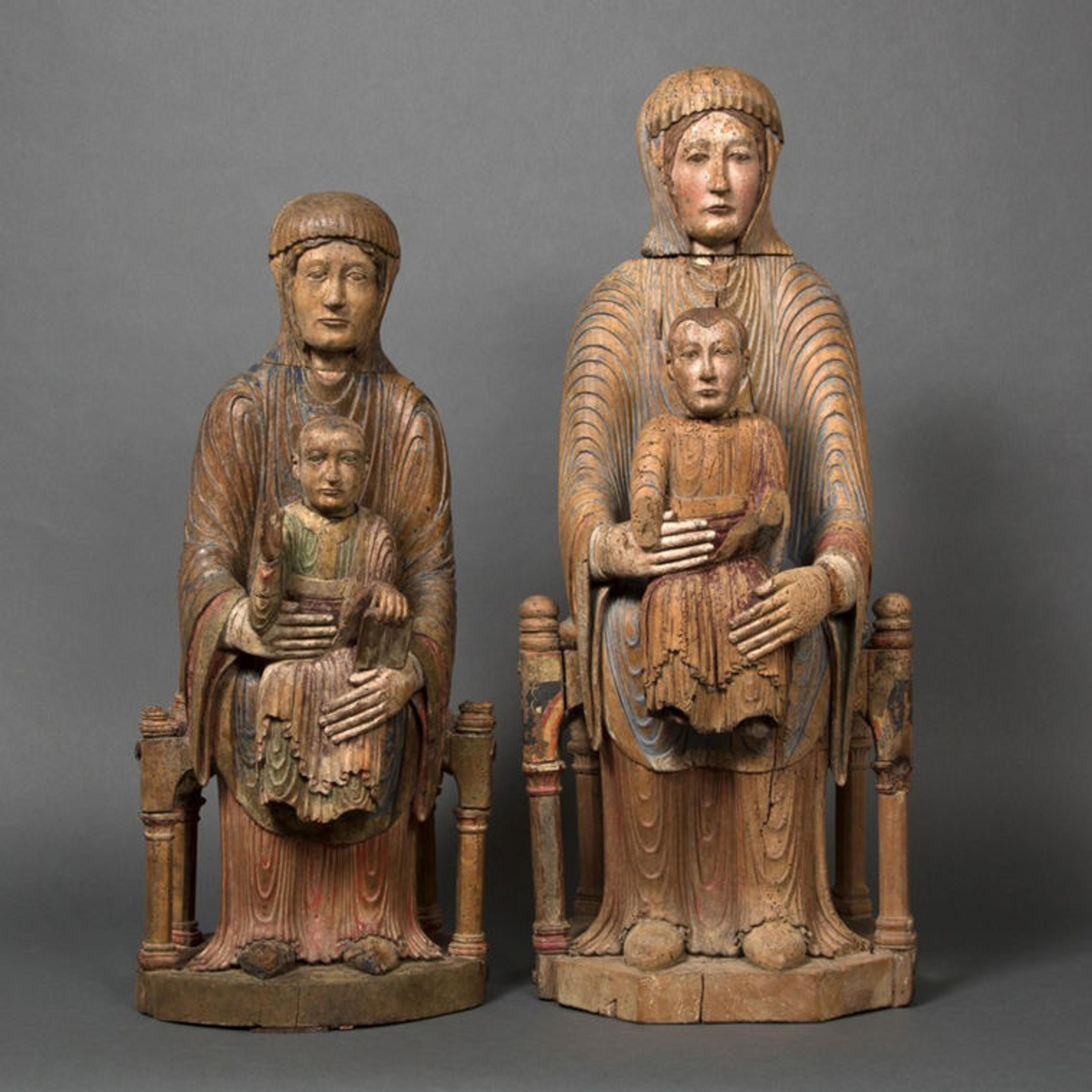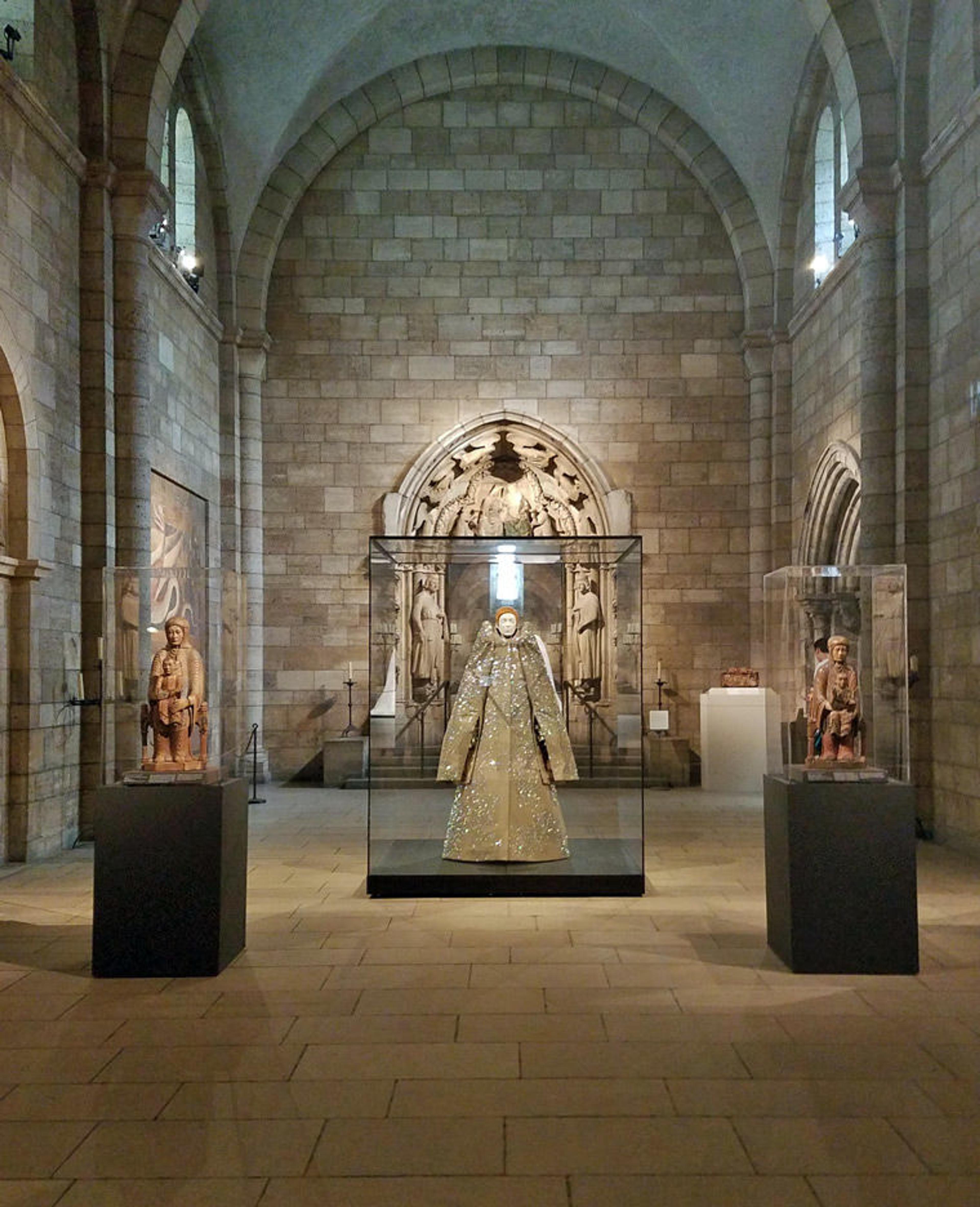
Gallery view of Heavenly Bodies: Fashion and the Catholic Imagination at The Met Cloisters, featuring Virgin and Child in Majesty (left) and Enthroned Virgin and Child (right) installed on either side of an ensemble by Viktor Horsting and Rolf Snoeren for Viktor & Rolf, from their autumn/winter 1999–2000 haute couture collection. Photo by the author
For the first time in more than eight hundred years, two Romanesque sculptures from the French Auvergne have been reunited. These works are now on view at The Met Cloisters as part of Heavenly Bodies: Fashion and the Catholic Imagination, The Costume Institute's spring exhibition, which places fashion in dialogue with the Museum's collection of medieval art.
One of the sculptures, Virgin and Child in Majesty—the so-called Morgan Madonna—was bequeathed to the Museum in 1916, and is usually a favorite stop in the Medieval Sculpture Hall at The Met Fifth Avenue. Its shorter sister, Enthroned Virgin and Child—also known as the Montvianeix Madonna—has been at The Met Cloisters since 1967. Both works are believed to have been produced by the same workshop in twelfth-century central France.
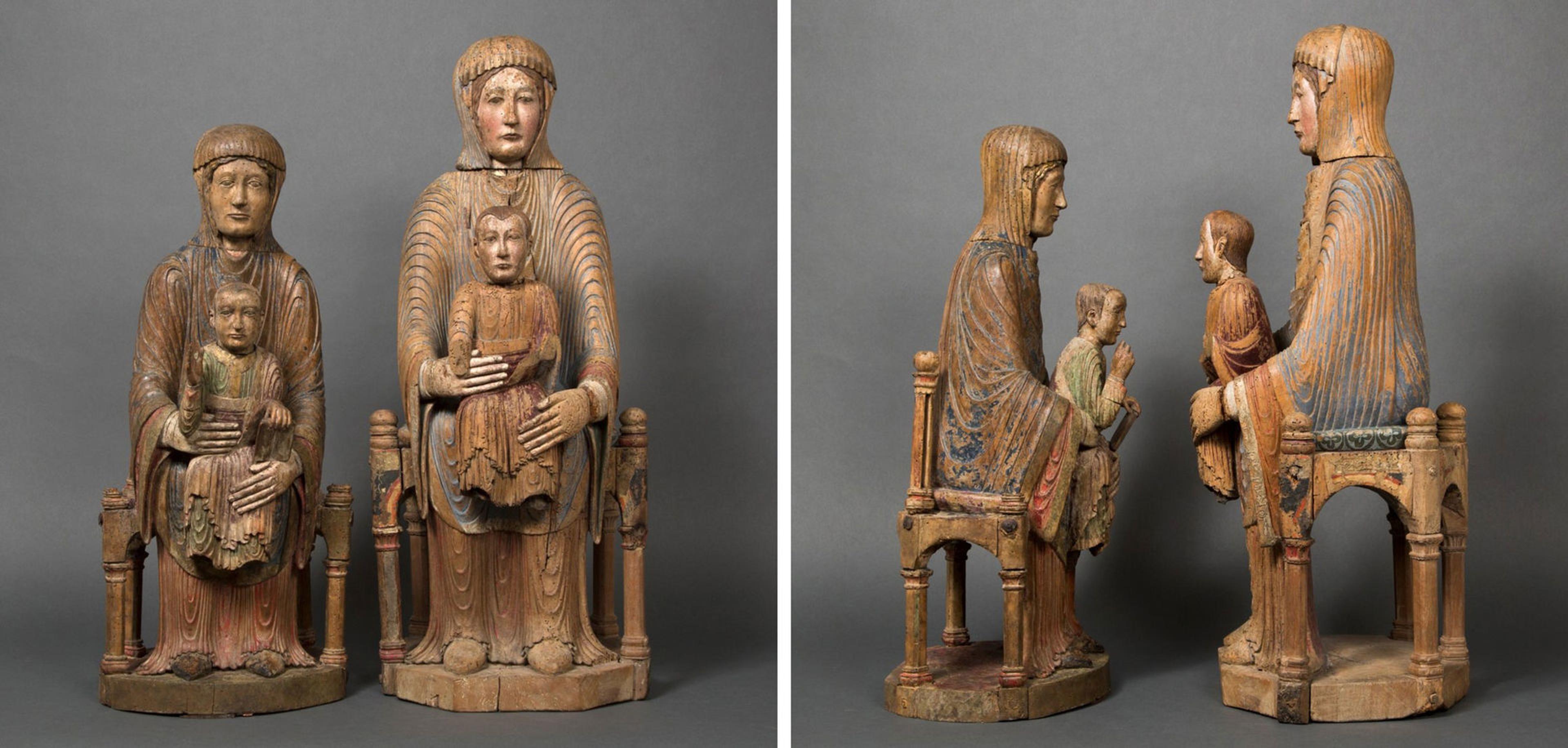
Left (in each image): Enthroned Virgin and Child, 1150–1200. Made in Auvergne, France. Walnut with gesso, paint, tin leaf, and traces of linen, 27 x 11 1/4 x 11 in. (68.6 x 28.6 x 27.9 cm). The Metropolitan Museum of Art, New York, The Cloisters Collection and James J. Rorimer Memorial Fund, 1967 (67.153). Right (in each image): Virgin and Child in Majesty, ca. 1175–1200. Made in Auvergne, France. Walnut with paint, tin relief on a lead white ground, and linen, overall: 31 5/16 x 12 1/2 x 11 1/2 in. (79.5 x 31.7 x 29.2 cm). The Metropolitan Museum of Art, New York, Gift of J. Pierpont Morgan, 1916 (16.32.194a, b)
It is always tempting for art historians, auction houses, or collectors to attribute works of art to a specific master. Unfortunately, there are very few identified artists in the Romanesque era, and many carry esoteric names such as Gislebertus from Autun; Gilabertus from Toulouse; or Wiligelmo from Modena, Italy. Scant information is known about wood carving practices in France during the early Middle Ages. At first, wood carvers belonged to monastic institutions, following technological traditions developed and preserved in that environment.
Sculptures of the Virgin and Child were abundantly carved to populate the proliferating churches at the time, and very little artistic license was spent in creating these works in the likes of the Morgan and Montvianeix Madonnas. Many follow a standard prototype—a variation on a theme—with the Virgin regally frontal, seated on a throne, tightly holding the Child with both hands. The Virgin's face is implacable, tight-lipped, without emotion, and the features of the Child look more like those of a little man.

Detail views of the Virgin's face on the Morgan Madonna (left) and the Montvianeix Madonna (right)
Despite a lack of facial expressions, The Met's two sisters project energy through the highly rhythmic folds of their garments, which are elliptic or linear in sequence and feature fluttering edges. Both hold the same visual schema.
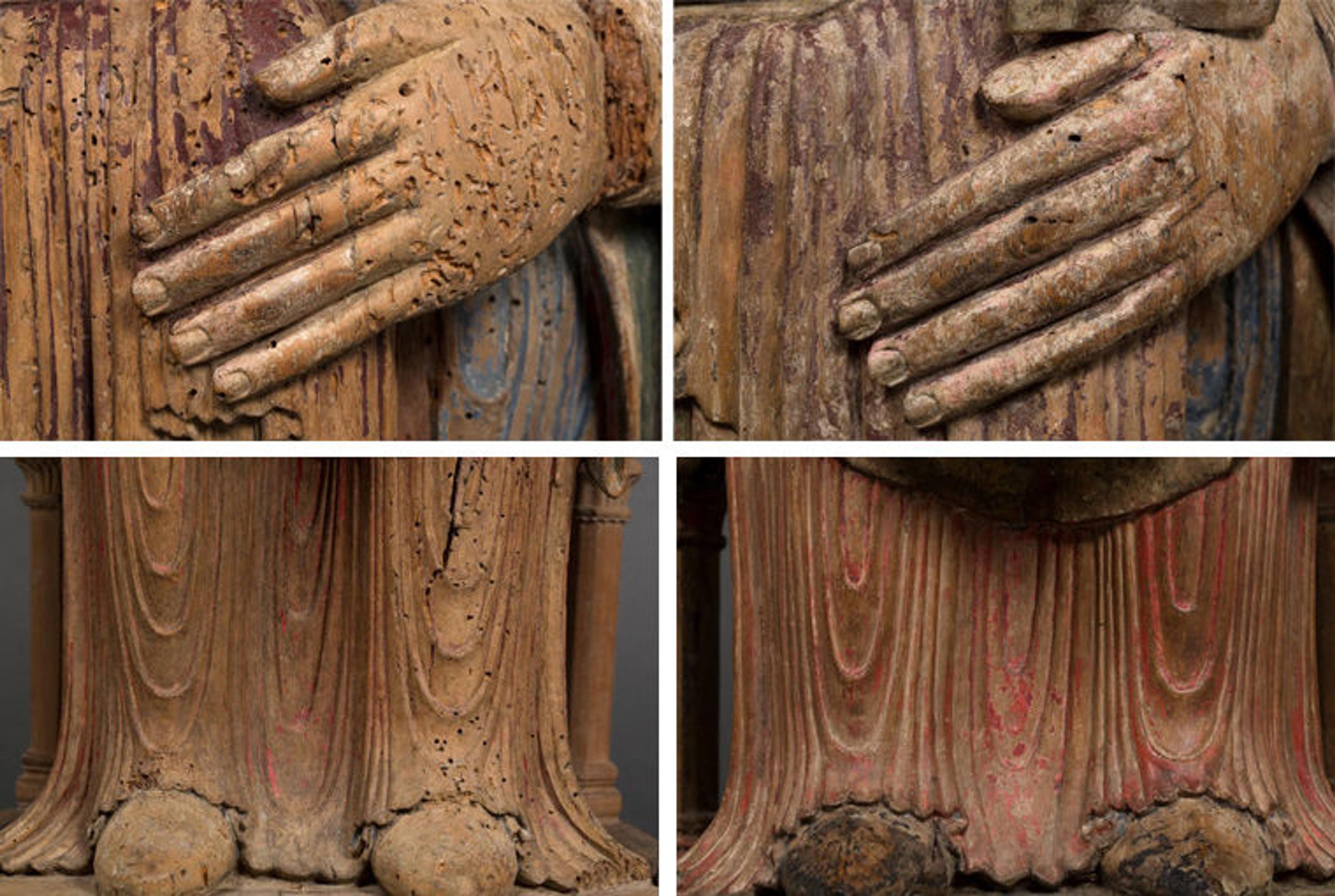
Detail views of the Morgan Madonna's left hand and garments (top and bottom left) and those of the Montvianeix Madonna (top and bottom right)
The joining techniques, wooden materials (nine blocks of walnut each), and carving tools used to create these works are also markedly similar, with variations in technique made apparent through subtler details in the carving and color schemes. The heads of both the Virgin and Child are separate, attached to the main section via columns to construct their respective thrones. The capitals are finished with varying details of delicate leaves.

Detail views of the capitals on the thrones of the Morgan Madonna (left) and the Montvianeix Madonna (right)
Through scientific analysis of the twelfth-century paint sequences, Associate Research Scientist Adriana Rizzo and I identified very similar palettes and incredibly sophisticated painting techniques. Both Virgins wear a blue mantle painted with ultramarine over a gray preparation. Sequences of red paints on the sculptures are also identical, with a darker red for Christ's mantle created by applying a lac glaze over an opaque layer of red ocher. In each case, the Virgin's dress is a layering of the same glaze over vermilion. Flesh tones are rendered in an oil technique on both sculptures, imparting a lustrous appearance to the skins.
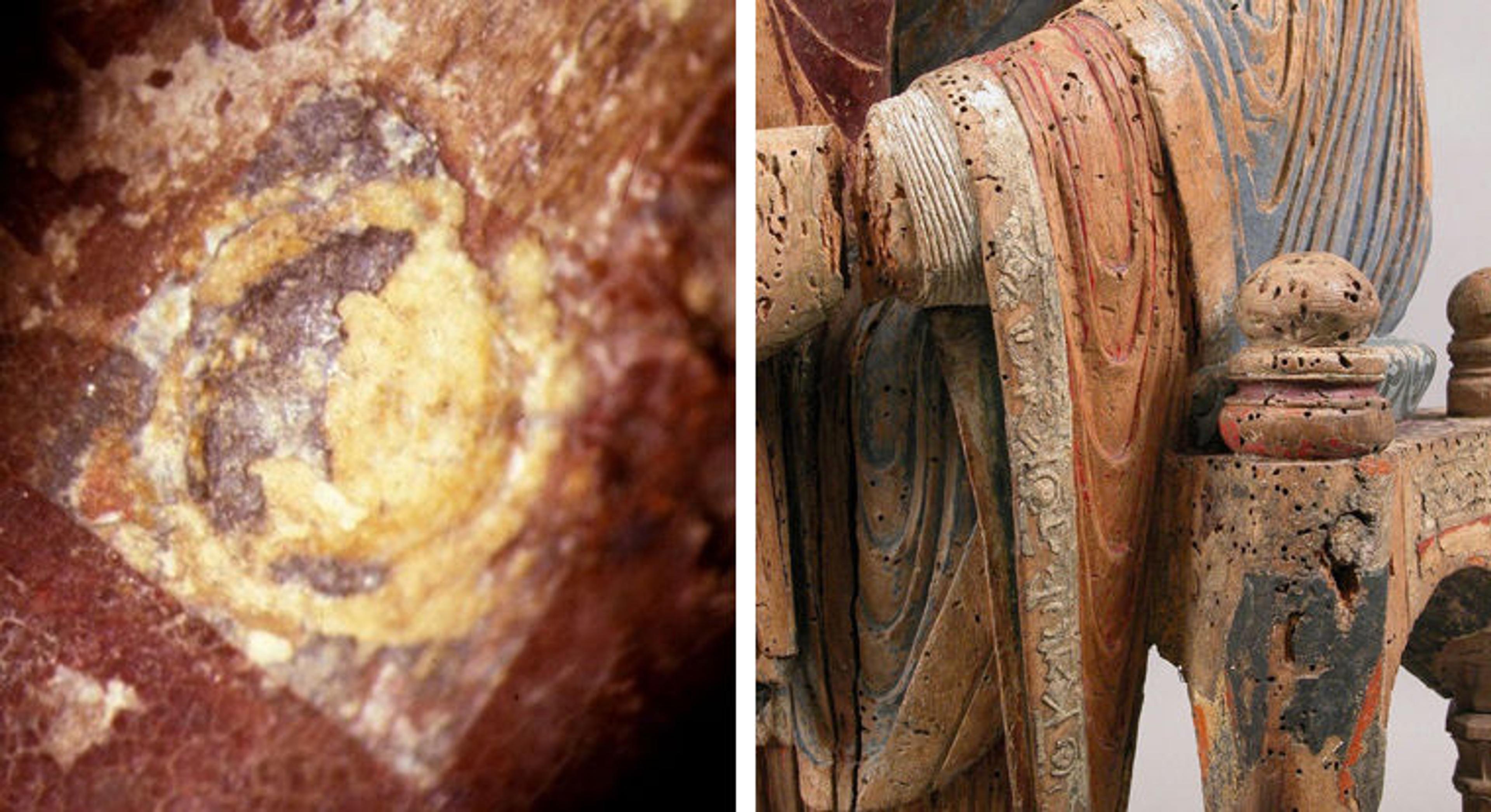
Left: Detail of tin-relief decoration on the Child's mantle. Photo by the author. Right: Detail view of the Morgan Madonna showing tin-relief decorations on the cuffs of the Virgin's robe
Differences lie in the use of relief decorations, which are scattered on the Montvianeix Child's mantle as small ring domes within squares, and on the Morgan Madonna's sleeves as continuous bands with similar geometric details. Their fabrication technique, however, is identical, made up of tin in relief covered with an amber-colored oil-resin coating, imitating gold. Another small variation can be seen on the Virgin's cushions—light blue with green quatrefoils for the Morgan, and pink with white quatrefoils for the Montvianeix.
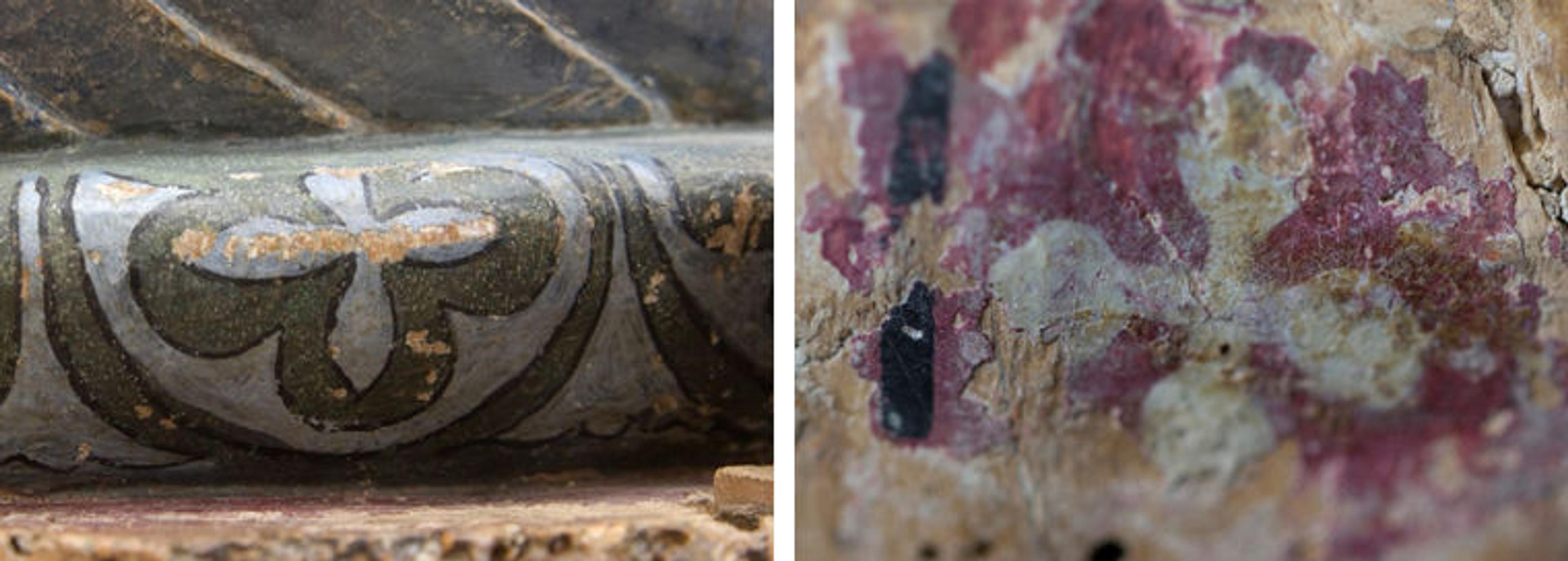
Detail views of the cushions on the thrones of the Morgan Madonna (left) and the Montvianeix Madonna (right). Photos by the author
Comparing and contrasting works of art is a visual training long exercised by scholars. Coupling formal analysis with technical investigation highlights the potential role that science can play in the domain of art history. In this case, the paired sculptures have many data points in common, and their differences are too minor not to be attributed to the same workshop, or even to the same anonymous hand, perhaps at different stages of the artist's maturity. We cannot be sure of this since freedom of expression in Romanesque times was very different from modern sensibilities, with sculpture production finding parallel perhaps in the act of monastic scribes copying texts to spread the message.
Related Content
Heavenly Bodies: Fashion and the Catholic Imagination is on view at The Met Fifth Avenue and The Met Cloisters through October 8, 2018.
Read more articles in this exhibition's blog series.
Purchase a copy of the Heavenly Bodies exhibition catalogue in The Met Store.
Kargère, Lucretia, and Adriana Rizzo. "Twelfth-Century French Polychrome Sculpture in The Metropolitan Museum of Art: Materials and Techniques." In Metropolitan Museum Studies in Art, Science, and Technology 1:39–72. New York: The Metropolitan Museum of Art, 2010.
